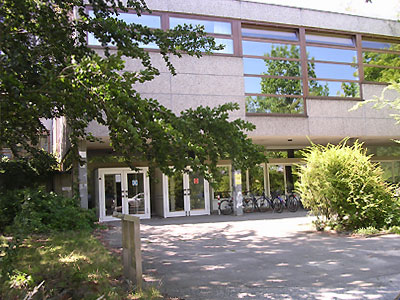User:Karsten Theis/Takustr6
From Proteopedia
Introduction
The Institute of Crystallography, part of the Chemistry department of the Free University Berlin, was located at Takustrasse 6. The macromolecular crystallography was on the third floor. It is still there, but the institutional framework has changed, and a new group has moved in. This page reminisces about research done from when the group moved to Berlin to the PIs retirement.
Results
| |||||||||||
Methods
The third floor was one big corridor, outlining the steps in structure solution. Cold rooms on one end, crystallization and X-ray labs in the middle (along with the two grown-up offices and the seminar room) and data crunching on the other end.
Purification
Crystallization
In-house data collection
Synchrotron data collection
Data processing
Structure solution
Structure refinement
1992: For every new structure, there would be two papers. The first describing the fold (in Science or Nature), the second "full paper" describing the details after refining the structure. Then, if you wanted, you would deposit your coordinates in the PDB. The diffraction data would be moved to magnetic tape as soon as a new project took up to much of your precious disk space quota.
Theoretical and computational work
Making figures
1992: FTP (yes, that's a verb) your coordinates to the Evans-and-Sutherland vector graphic machine (sign up first). Find the perfect orientation of your model (in stereo, if necessary), apply rub-off lettering directly on the screen for labels, and set up a tripod for the camera to take pictures. If you were in a hurry, run down to the photography lab in the basement to develop your film and make copies of the negatives (unless you were making slides for a talk). Then, patiently take off all the lettering and start over because someone wanted a different view, maybe 3 degrees rotation around the y-axis.
Publishing
1992: We had computers, even PCs, but they were slow. You would find out if you had your entire PhD thesis in a single document and tried to go from chapter 1 to chapter 4 after making changes. Word had to re-paginate the entire document, which would take longer than making a pot of coffee and drinking it. Others used LaTeX on the mainframe, entering text on a VT100 terminal.
Model building
1990s: Every time a new structure was solved, we would build a physical model. Well, we would have a crystallography course, and participants would build stretches of ten amino acids from a list of main-chain and side-chain torsion angles. Then, we would assemble those on a wooden board with aluminum stakes, guided by the projection of the C-alpha trace taped to the wooden board. At the end, the technician from downstairs would build a plexiglass housing to avoid tampering with the structure (see Discussion, occupational hazards). It was reminiscent of a hunter putting skulls and antlers of the kill on the wall.
Conferences
Discussion
see discussion page, second tab on the top
Footnotes
- ↑ Karsten: back then, you could ask for a specific PDB ID, and researchers tried to get one that fit their project. nRNT for RNase T1 is pretty good, but at one point the lab ran out of digits
- ↑ Karsten: Looking back, I'm amazed that only five years passed between the 4 Angstrom model and the complete atomic model of photosystem I. To me, folks working on that project were in a different space-time continuum. Everything took longer, the unit cell dimensions were crazy, the solvent content unbelievable, and then the did these things like advancing the spindle every three images because they were burning through the crystal, or using a cylindrical image plate in Japan in hopes of spreading out the overlapping diffraction spots. And then there was airport security: "No, you can't X-ray that, sorry. It's in the thermos to keep it cool. No, you can't look inside, it is light sensitive. Yes, trust me." I am still impressed by the graduate students who dared to join this project.

